Recent Fire Damage Posts
Is That A Spiderweb?
5/24/2023 (Permalink)
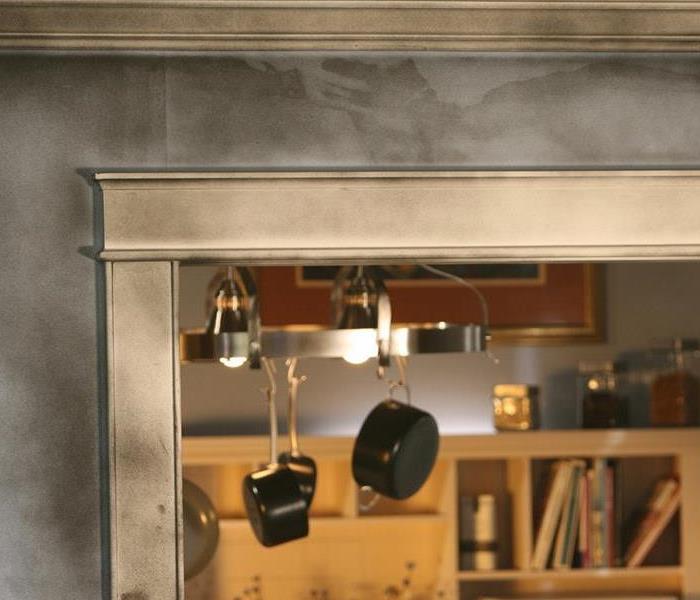 We understand how to clean up any disaster.
We understand how to clean up any disaster.
Being fire restoration specialists, we have seen a lot of fire damaged homes and businesses in our area over the years.
Fires create heat and release both smoke and soot. Smoke is a vapor made up of very fine particles, while soot is a solid made from powdery or oily carbon and tar.
One of the most common visible instances of fire damage are the black spider webs that seem to spring out of nowhere after a fire. It's what looks like a spider web, but in reality it isn't.
Soot tags are thread-like chains made from carbon and tar released as a fire burns. They are also called soot webs because they look so similar to spider webs or cobwebs. In fact, most people assume they actually are spider webs.
Call SERVPRO of York, James City County & Poquoson for any and all fire needs at 757-229-3442 or toll free at 1-800-889-5002. We have the knowledge to both take care of your home and help you learn about what is "typical" in a fire damaged building or home.
Bonfire Safety
5/24/2023 (Permalink)
Bonfires can be outdoor fun no matter the season. Residents of York County can often times have their very own small bonfire. There are times when a Permit is required, check out this link to apply for a permit Open Burning Regulations | York County, VA
Follow these helpful tips for a bonfire:
Approved bonfire permits typically require that the bonfire be located at least 50 feet from any structure on the permittee property and not less than 250 feet from any structure on adjacent property. Bonfires shall be constantly attended until the fire is extinguished. A minimum of one portable extinguisher (minimum size 3A40BC) or approved on-site fire extinguishing equipment, such as dirt, sand, water barrel, and garden hose shall be available for immediate utilization. Other conditions may be established as determined during the permit review and approval process.
Check out this site for more information
https://www.yorkcounty.gov/DocumentCenter/View/704
Homeowners can burn small piles of yard debris, leaves, and brush as long as they meet these requirements: Between February 15 and April 30, State forest laws prohibit open burning before 4:00 p.m. (may burn only until 9:00 p.m.). check out this site for more information
https://www.yorkcounty.gov/DocumentCenter/View/706
- The burning pile is 50 feet or more away from the dwelling.
- It is in a controlled pile where there is no opportunity for fire spread.
- The burning pile must not contain any refuse of plastics, rubber, hazardous materials, or petroleum products.
- Any pile larger than normal household brush clearance MUST have a permit issued from the Fire Marshal's office, especially burning for the purposes of land clearing. If a permit is required, it MUST be obtained by the Fire Marshal's office at least 14 days prior to the start of burning.
There are also some general safety precautions to bonfires in general:
- Check the weather. Never build a bonfire on a high-wind night.
- Keep a bucket of water or garden hose nearby in case the fire begins to spread. It is important to be prepared in case of emergency.
- Keep a close eye on the bonfire as well as children nearby. This will help protect others around you.
- Do not burn aerosols, canisters or anything containing foam or paint. These types of chemicals have extremely flammable ingredients that can cause fire to spread or produce toxic fumes. Containers of these products could explode, causing injury.
- Ensure the wood you are burning is dry and seasoned. This means no railroad ties, nothing coated or treated and no furniture should be thrown in the fire.
- The pile shouldn't be bigger than 5' x 5' to keep the flames containable.
The most important part of a successful bonfire is making sure that it is put out properly. After the bonfire is done, turn over the charred materials with metal shovels and rakes, and douse the area with water. Once you extinguish your fire with water, gently stir and spread the ashes to cool. Leave only when they’re cool to the touch.
Follow these safety tips to have a fun and successful bonfire.
Did you know batteries can be dangerous?
5/24/2023 (Permalink)
Experts recommend replacing the batteries in your home’s smoke detectors at least twice a year. Every time we change the clocks we should change the batteries in our smoke detectors.
Disposing of old batteries isn’t always as simple as throwing them in the trash. What are you supposed to do with the old batteries?
Batteries can be especially dangerous when disposed of together. In one instance from April 2011, a man accidentally burned down his family’s home with nothing more than a few 9-volt batteries. He had changed the batteries in his smoke detectors, placing the old batteries in a separate bag to recycle later. When the bag was moved, the batteries’ terminals contacted one another, causing the fire.
The best way to prevent this from happening in your home is to place a piece of electrical tape over the terminals of old batteries before you dispose of them.
You should store new batteries in the packaging they came in and not thrown loosely in a drawer.
This simple step can save your home and save the lives of those around you by preventing a fire in an unexpected location like a garbage bag or junk drawer.
If you need SERVPRO of York, James City County & Poquoson to help with a fire damage at your home or business we are only a call away
Call 757-229-3442 or toll free 1-800-889-5002
Is that a Spider Web?
3/23/2022 (Permalink)
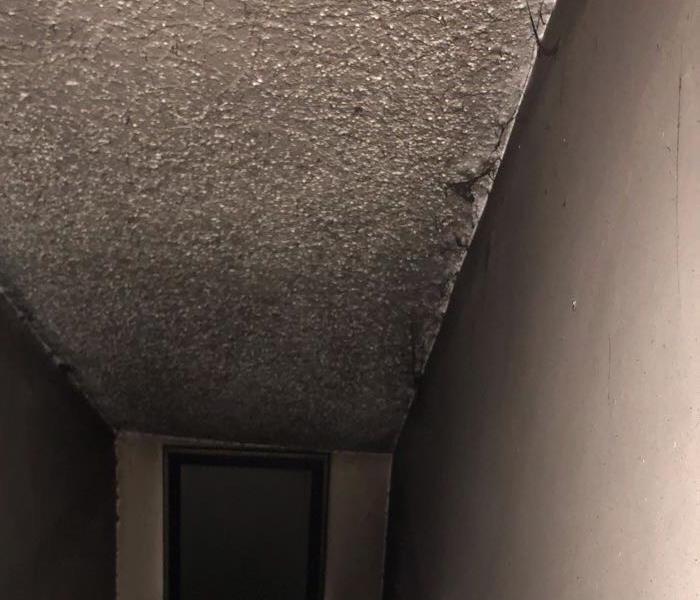 Soot Webs in Hallway in a house fire in Newport News, VA
Soot Webs in Hallway in a house fire in Newport News, VA
Being fire restoration specialists, we have seen a lot of fire damaged homes and businesses in our area over the years.
Fires create heat and release both smoke and soot. Smoke is a vapor made up of very fine particles, while soot is a solid made from powdery or oily carbon and tar.
One of the most common visible instances of fire damage are the black spider webs that seem to spring out of nowhere after a fire. It's what looks like a spider web, but in reality it isn't.
Soot tags are thread-like chains made from carbon and tar released as a fire burns. They are also called soot webs because they look so similar to spider webs or cobwebs. In fact, most people assume they actually are spider webs.
Call SERVPRO of York, James City County & Poquoson for any and all fire needs at 757-229-3442 or toll free at 1-800-889-5002. We have the knowledge to both take care of your home and help you learn about what is "typical" in a fire damaged building or home.
Grilling Safety Tips
3/23/2022 (Permalink)
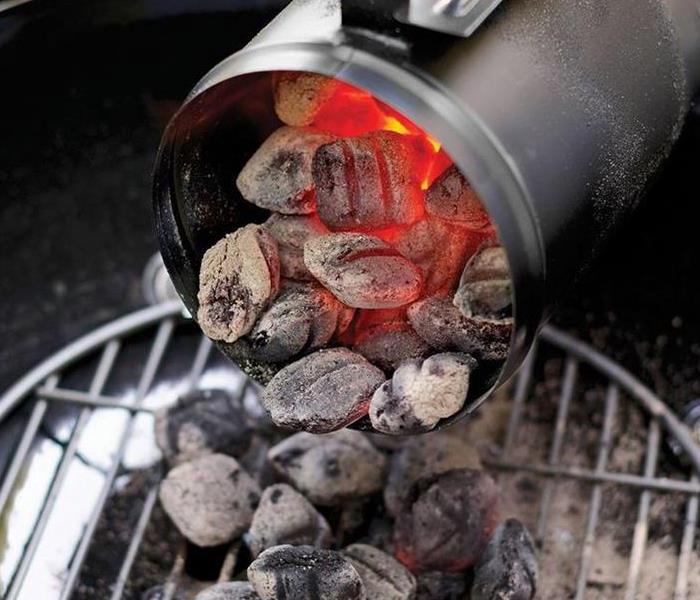 Grilling Safety Tips
Grilling Safety Tips
U.S. Grilling Statistics:
Did you know that seven out of every ten people in the United States have a grill or smoker? According to the National Fire Protection Association (NFPA), between 2014 and 2018, fire departments responded to over 8900 home fires involving grills, hibachis, or barbeques per year.
SERVPRO of York, James City County & Poquoson responds to fire damage emergencies throughout the year and we offer these grilling safety tips from the NFPA to help you stay safe while grilling on a charcoal grill:
Charcoal Grill Safety
- There are several ways to get the charcoal ready to use. Charcoal chimney starters allow you to start the charcoal using newspaper as fuel.
- If you use a starter fluid, use only charcoal starter fluid. Never add charcoal fluid or any other flammable liquids to the fire
- Keep charcoal fluid out of the reach of children and away from heat sources
- There are also electric charcoal starters, which do not use fire. Be sure to use an extension cord for outdoor use.
- When you are finished grilling, let the coals completely cool before disposing in a metal container
Call Us Today!
SERVPRO of York, James City County, & Poquoson offers a full range of fire restoration and deodorization services to return your home or commercial business to preloss condition with minimal disruption. Call us today at 757-229-3442 or toll free at 1-800-889-5002. We’ll restore your fire damage in York, “Like it never even happened.”
Bonfire Safety
3/14/2022 (Permalink)
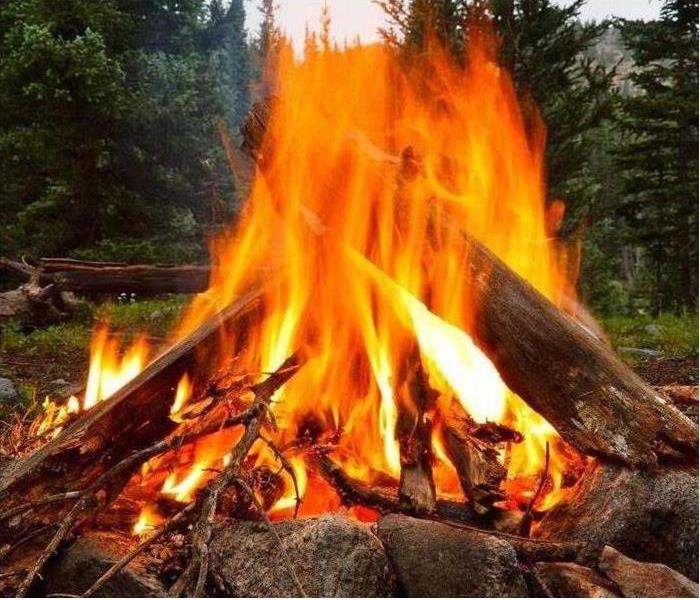 Call us for all your fire needs
Call us for all your fire needs
Bonfires can be outdoor fun no matter the season. Residents of York County can often times have their very own small bonfire. There are times when a Permit is required, check out this link to apply for a permit Open Burning Regulations | York County, VA
Follow these helpful tips for a bonfire:
Approved bonfire permits typically require that the bonfire be located at least 50 feet from any structure on the permittee property and not less than 250 feet from any structure on adjacent property. Bonfires shall be constantly attended until the fire is extinguished. A minimum of one portable extinguisher (minimum size 3A40BC) or approved on-site fire extinguishing equipment, such as dirt, sand, water barrel, and garden hose shall be available for immediate utilization. Other conditions may be established as determined during the permit review and approval process.
Check out this site for more information
https://www.yorkcounty.gov/DocumentCenter/View/704
Homeowners can burn small piles of yard debris, leaves, and brush as long as they meet these requirements: Between February 15 and April 30, State forest laws prohibit open burning before 4:00 p.m. (may burn only until 9:00 p.m.). check out this site for more information
https://www.yorkcounty.gov/DocumentCenter/View/706
- The burning pile is 50 feet or more away from the dwelling.
- It is in a controlled pile where there is no opportunity for fire spread.
- The burning pile must not contain any refuse of plastics, rubber, hazardous materials, or petroleum products.
- Any pile larger than normal household brush clearance MUST have a permit issued from the Fire Marshal's office, especially burning for the purposes of land clearing. If a permit is required, it MUST be obtained by the Fire Marshal's office at least 14 days prior to the start of burning.
There are also some general safety precautions to bonfires in general:
- Check the weather. Never build a bonfire on a high-wind night.
- Keep a bucket of water or garden hose nearby in case the fire begins to spread. It is important to be prepared in case of emergency.
- Keep a close eye on the bonfire as well as children nearby. This will help protect others around you.
- Do not burn aerosols, canisters or anything containing foam or paint. These types of chemicals have extremely flammable ingredients that can cause fire to spread or produce toxic fumes. Containers of these products could explode, causing injury.
- Ensure the wood you are burning is dry and seasoned. This means no railroad ties, nothing coated or treated and no furniture should be thrown in the fire.
- The pile shouldn't be bigger than 5' x 5' to keep the flames containable.
The most important part of a successful bonfire is making sure that it is put out properly. After the bonfire is done, turn over the charred materials with metal shovels and rakes, and douse the area with water. Once you extinguish your fire with water, gently stir and spread the ashes to cool. Leave only when they’re cool to the touch.
Follow these safety tips to have a fun and successful bonfire.
Do you ever wonder why Fire and Water Damage Restoration Professionals use Air Scrubbers on many of their jobs including fire or water clean-up jobs?
12/16/2021 (Permalink)
 This picture shows one air scrubber that can be used to help remove gasses, particles and or odors from affected area.
This picture shows one air scrubber that can be used to help remove gasses, particles and or odors from affected area.
This specialty piece of machinery creates a safe working environment for the crews that are working in the damaged environment. Air scrubbers can also prevent damage from spreading to other structural building materials and limits contents from absorbing the odors.
These devices are utilized to clean the air from the odors and toxic gases that are left over after the fire has been extinguished or the residual odors from a water loss.
This is achieved by changing over the air in the damaged structure at a minimum of three to four times per hour. We accomplish this by setting up the machines under positive air flow or negative air flow. Which type of air flow needed is determined by the situation and or the severity of the job. This specialty piece of equipment helps our crews reduce or eliminate smoke or soot residue, ash particles and any other residues which are present after a fire or water damage.
Some may ask?
Will an Air Scrubber Help With Bad Odors?
It sure will. When an air scrubber “scrubs” pollutants from the air, it essentially obliterates them – along with their unpleasant odors. Air scrubbers can help eliminate common household odors associated with pets, cigarette smoke, paint fumes, mold spores… and even burnt food!
If you have questions or need help with any deodorization, please call SERVPRO of York, James City County & Poquoson at 757-229-3442 or toll free at 800-889-5002
Fire Extinguisher Take 2
12/16/2021 (Permalink)
 The Occupational Safety and Health Administration suggest that users use the P.A.S.S. technique.
The Occupational Safety and Health Administration suggest that users use the P.A.S.S. technique.
Hopefully you will never be in a situation where you will need it, but it is important to understand the proper techniques for fire extinguisher use in order to keep your home safe and be able to respond in case of emergency.
With the holidays in full swing, it is important to be aware of your surrounds and keeping an eye out on candles, gas logs, cooking elements and overloaded outlets.
Extension cords should not be connected to another extension cord. When decorating this year, it is important to distribute the outlet usage and not plug too many items in one.
Everyone loves to burn candles while entertaining guest or family or friends just some tips to remember this year Make sure you never burn a candle on or near anything that can catch fire. Keep burning candles away from furniture, drapes, bedding, carpets, books, paper, flammable decorations, etc.
With candles also remember children and pet, always keep them out of reach and remember to trim candlewicks each time before burning recommend ¼ inch
Check your Fire Extinguisher frequently to make sure it's in proper working order because most fire extinguishers do not come with an expiration date.
If you find yourself in need to use a fire extinguisher remember to P.A.S.S
- Pull the pin. Hold the extinguisher with the nozzle pointing away from you and release the locking mechanism.
- Aim low. Point the extinguisher at the base of the fire.
- Squeeze the lever slowly and evenly.
- Sweep the nozzle from side-to-side.
Also R.A.C.E
RESCUE, ALARM, CONFINE, EXTINGUISH/EVACUATE.
SERVPRO of York, James City County & Poquoson want you to be prepared and know the importance of fire safety! If something happens and you need our help, we are a phone call away. 757-299-3442 or toll free 800-889-5002
Homeowner Fire Prevention Tips
3/21/2021 (Permalink)
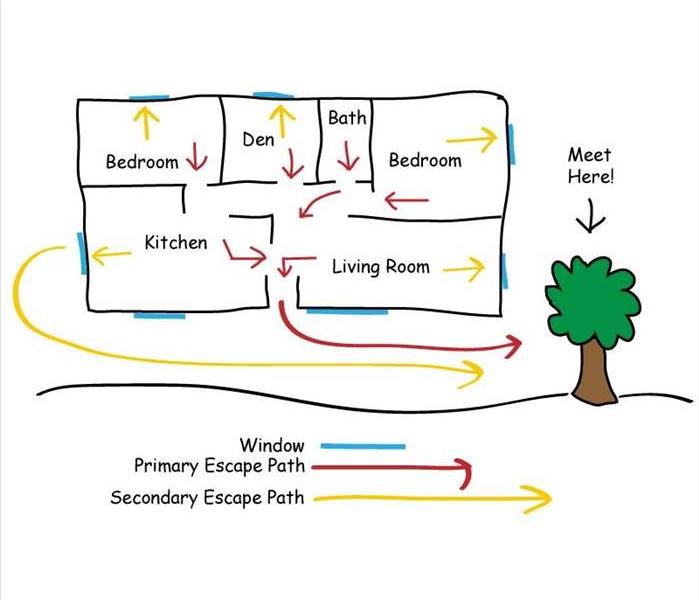 Have a plan
Have a plan
If there is one common practice that everyone was taught in school it was to stop, drop, and roll in the case of a fire. While this common practice has been all but drilled into us in childhood there is one piece of information that is often forgotten in the midst of a fire, preparation. Being prepared in the case of a fire is your best bet for keeping yourself and your family safe. Here are five tips to prevent a fire.
Make sure that all smoke alarms and carbon monoxide detectors are functional in your home.
Just having a smoke alarm and carbon monoxide detector in your home is not enough. It is extremely important to verify that these instruments are working how they are intended too.
Invest in fire extinguishers and sprinklers.
It is important to have fire extinguished and sprinklers in the home as they can help prevent the spread of small fires. A fire extinguisher should be used when a fire is confined to a small space. Remeber these acronyms when you are using a fire extinguisher
R.A.C.E. RESCUE, ALARM, CONFINE, EXTINGUISH/EVACUATE.
P.A.S.S.
- Pull the pin. Hold the extinguisher with the nozzle pointing away from you and release the locking mechanism.
- Aim low. Point the extinguisher at the base of the fire.
- Squeeze the lever slowly and evenly.
- Sweep the nozzle from side-to-side.
Stay alert while cooking.
Kitchen fires are very frequent causes of fires. It is important to know how to put out a grease fire. Grease fires is not to be doused in any kind of liquid. A liquid on a grease fire will only work to expand the already growing fire. A better method is if the fire is in a pan to cover it completely with a metal lid or a baking sheet. It is best to also call 911.
Have a plan.
It is very important to not only be avidly working to have a preventative plan in case of a fire but to also to have an up to date backup plan. An escape plan is crucial to ensuring that individuals are calm and not panicked.
Despite how prepared one might be there are still events that result in fires that are uncontrollable. That is where SERVPRO steps in to help. Fire clean up should be left up to a professional that can aid in minimizing the fire damage as much as possible.
If you need any help with fire clean up give SERVPRO of York, James City County, and Poquoson a call.
757-229-3342 or toll free at 1-800-889-5002
SERVPRO cares and are always here to help!
Be Safe With Your Space Heater
3/20/2021 (Permalink)
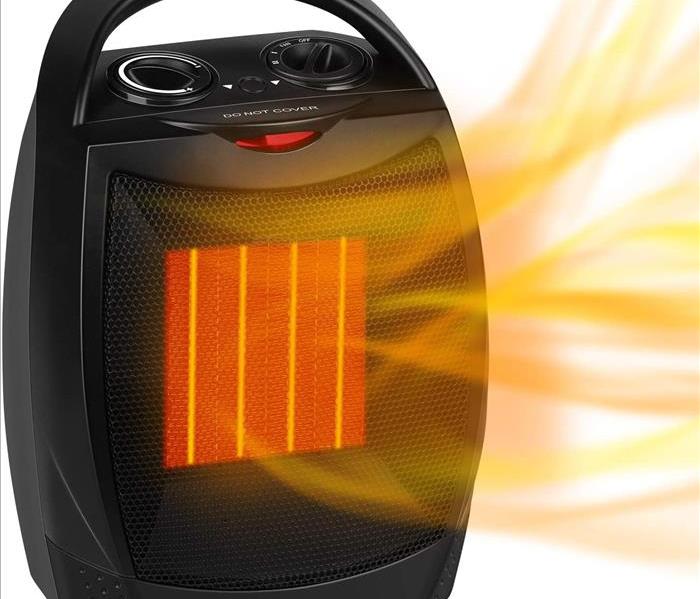 Be Safe With Your Space Heater
Be Safe With Your Space Heater
Space heaters are designed to supplement cold rooms and must be used with extreme caution. According to the National Fire Prevention Association (NFPA), nearly half of all home heating fires occur during the peak months of December, January, and February.
According to NFPA - Space heaters are the type of heating equipment most often involved in home heating fires, figuring in two of every five of these fires and accounting for 86% of associated civilian deaths, 78% of civilian injuries, and 54% of direct property damage.
General Guidelines for Space Heater Safety
There are several ways people can prevent accidental fires in their homes. One of the most important is to select heaters that have been tested and certified by testing laboratories. Also, keep areas around the heat source free of paper and trash.
When choosing the placement of the heater, remember the three feet safety rule by keeping everything that can burn at least three feet away from the heat source. Only use the heaters to heat the small space.
Place the space heater on a hard level nonflammable surface, never on carpet, blankets, or rugs. Never use a defective heater or one that is missing its heating element guard. Make sure you use the proper size space heater for the room.
When purchasing a new space heater, look for a model with an automatic shut-off in case the heater is left on too long. In addition, a tip-switch will automatically cut off the heat if the unit topples over. Even with the safety features, never leave the heater on when sleeping, out of the room, or away from home.
If you use space heaters please use with caution and make sure its not being used inappropriately.
Give SERVPRO of York, James City County, and Poquoson call at 757-229-3442 or toll free at 1-800-889-5002!
Smoke and Soot Cleanup
3/14/2021 (Permalink)
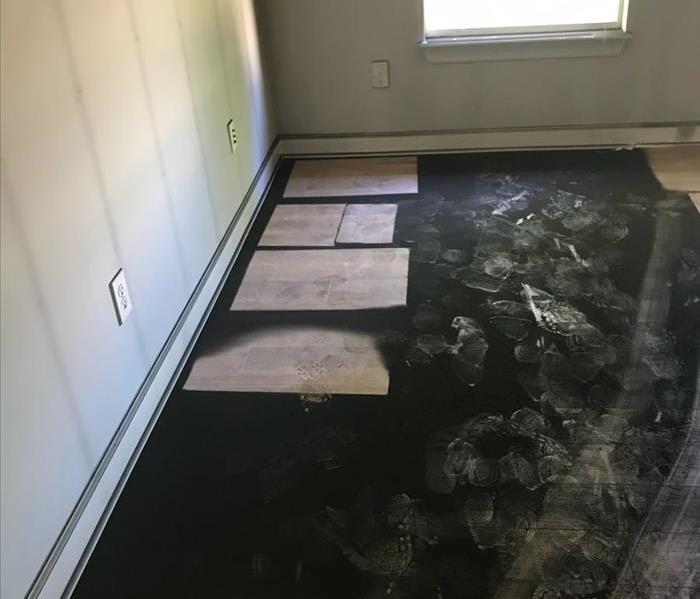 a home in williamsburg with soot damange
a home in williamsburg with soot damange
Smoke and soot is very invasive and can penetrate various cavities within your home, causing hidden damage and odor. Our smoke damage expertise and experience allows us to inspect and accurately assess the extent of the damage to develop a comprehensive plan of action.
Smoke and soot facts:
- Hot smoke migrates to cooler areas and upper levels of a structure.
- Smoke flows around plumbing systems, seeping through the holes used by pipes to go from floor to floor.
- The type of smoke may greatly affect the restoration process.
Different Types of Smoke
There are two different types of smoke–wet and dry. As a result, there are different types of soot residue after a fire. Before restoration begins, SERVPRO of York, James City County, Poquoson will test the soot to determine which type of smoke damage occurred. The cleaning procedures will then be based on the information identified during pretesting. Here is some additional information:
Wet Smoke – Plastic and Rubber
- Low heat, smoldering, pungent odor, sticky, smeary. Smoke webs are more difficult to clean.
Dry Smoke – Paper and Wood
- Fast burning, high temperatures, heat rises therefore smoke rises.
Protein Fire Residue – Produced by evaporation of material rather than from a fire
- Virtually invisible, discolors paints and varnishes, extreme pungent odor.
Our Fire Damage Restoration Services
Since each smoke and fire damage situation is a little different, each one requires a unique solution tailored for the specific conditions. We have the equipment, expertise, and experience to restore your fire and smoke damage. We will also treat your family with empathy and respect and your property with care.
Have Questions about Fire, Smoke, or Soot Damage?
Call Us Today – SERVPRO of York, James City County, and Poquoson
757-229-3442 or toll free at 1-800-889-5002
SERVPRO cares and we are here to help with any of your fire, smoke or soot needs.
Not All Fires Are The Same
3/2/2021 (Permalink)
 Soot Damage in Kitchen.
Soot Damage in Kitchen.
There are five main categories of fires and their extinguishers. As a homeowner or a business owner it is important to be aware in order to prevent fire damage.
Class A
These are the most common type of fires. They involve combustible materials such as wood, paper, cloth, trash, or plastic. Fire extinguishers under Class A use a water and or various types of dry chemicals to either absorb heat or coat the fire. These are the easiest of the classes to extinguish.
Class B
These involve ignitable liquid or gases such as grease, alcohol, paint, propane, or gasoline. Fire extinguishers under Class B work best on oil or fuel-based fires.
Class C
These involve electrical equipment such as old wiring in walls, frayed electrical cords, worn out breaker boxes, or faulty appliances. Fire extinguishers under Class C release materials that stop the conduction of electricity.
Class D
These are fairly rare. They involve metals igniting commonly in laboratories and industrial settings such as potassium, magnesium, aluminum, and sodium.
Class K
These involves cooking oils and fats and usually occur when a pan is left unattended for too long on a stove. They are often lumped in with Class B, however the US Fire Administration states that it is in a category of its own. Fire extinguisher under Class K release an alkaline agent to create a foam that traps vapor to put out the fire.
Make sure that you properly use a fire extinguisher with the PASS Method.
Make sure that you use the RACE method
RESCUE, ALARM, CONFINE, EXTINGUISH/EVACUATE.
If you experience any fire damage in your home and need remediation give SERVPRO of York, James City, and Poquoson a call at 757-229-3442 of toll free at 1-800-889-5002.
SERVPRO is here to help in your time of need
Sources:
https://www.safety.com/types-of-fires-and-extinguishers/
Have you Heard of the P.A.S.S Method?
2/12/2021 (Permalink)
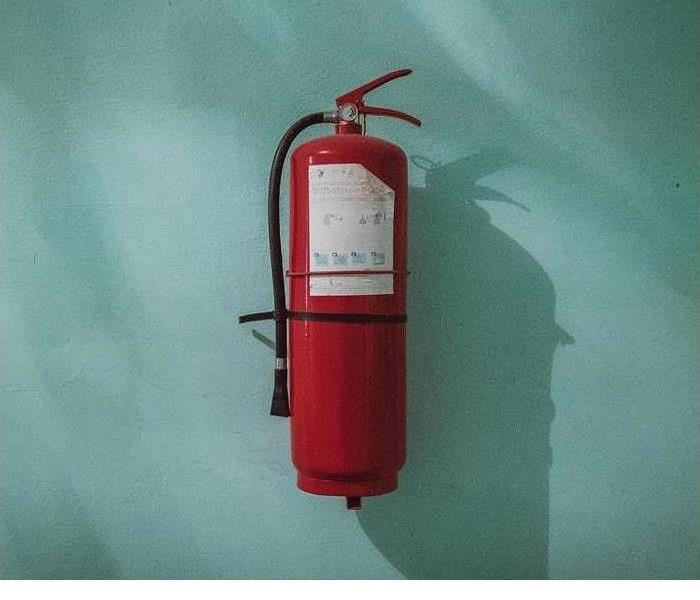 fire extinguisher
fire extinguisher
Having a fire extinguisher in you home can be very useful for preventing any extensive fire damage. Though it is important to also know how to properly use it. The Occupational Safety and Health Administration suggest that users use the P.A.S.S. technique.
Pull: pull the pin
Aim: Aim low, pointing the extinguisher nozzle at the base of the fire
Squeeze: Squeeze the handle to release the extinguishing agent
Sweep: sweep from side to side at the base of the fire until it appears to be out. Watch the area. If it re-ignites repeat steps 2-4.
Inpsect your fire extingusher at least once a year to make sure it hasnt expired, when it has expired replace and expose of the old one properly.
If you experience any fire damage in your home and need remediation give SERVPRO of York, James City, and Poquoson a call at 757-229-3442.
Fire Damage - tips for while you wait
8/7/2019 (Permalink)
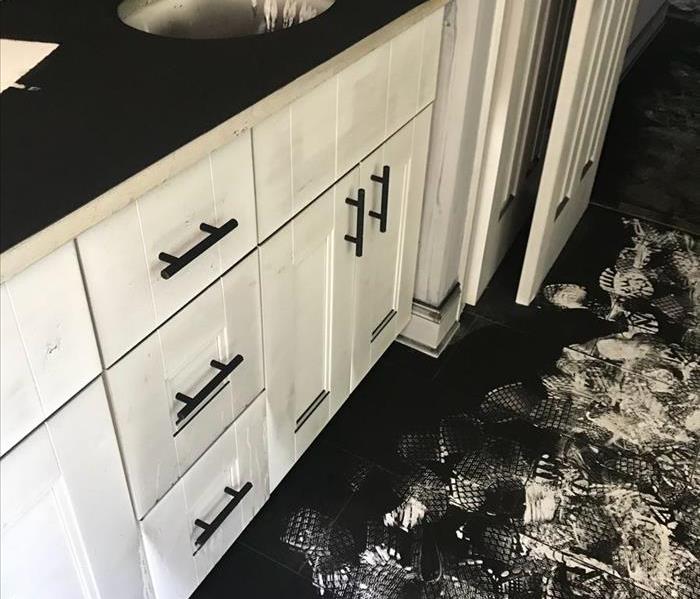 Got SOOT? We can help with that!
Got SOOT? We can help with that!
When fire damage happens at your home or property it is a terrifying moment, because you don’t know what to do once everyone has made it out safely. So here are some tips to help you while you wait for our crews to reach your property:
Limit movement in the home to prevent soot particles from being embedded into upholstery and carpet
Keep hands clean. Soot on hands can further soil upholstery, walls, and woodwork
Place dry, colorfast towels or old linens on rugs, upholstery and carpet traffic areas
If electricity is off, empty freezer/fridge completely and prop doors opens to help prevent odor
Wipe soot from chrome kitchen/bathroom faucets, trim, appliances then protect these surfaces with a light coating of lubricant
If heat is off during winter, pour RV antifreeze in sinks, toilet bowls, holding tanks, and tubs to avoid freezing pipes
Change HVAC filter; leave system off until a trained professional can check the system
Tape double layers of cheesecloth over air registers to stop particles of soot from getting in or out of the HVAC
If you have a fire event in your home please reach out to SERVPRO at 757-229-3442 so we can help get your home back to normal
Deodorization
5/22/2018 (Permalink)
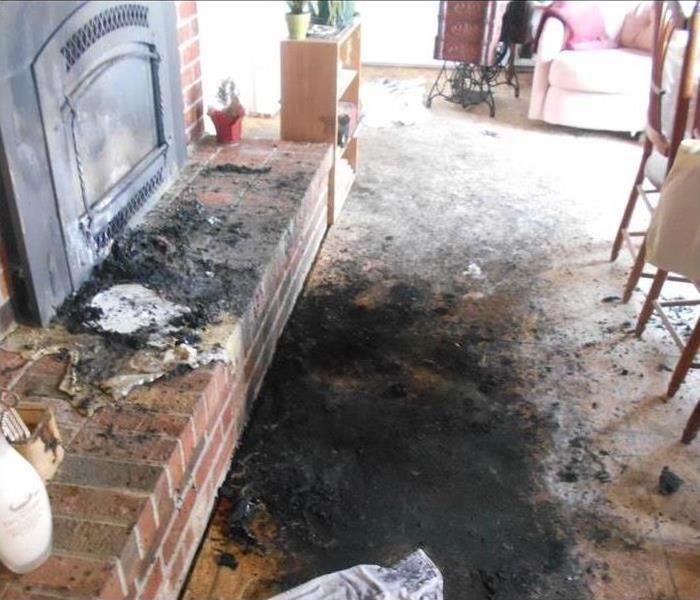 Soot from the fire place
Soot from the fire place
Even a small fire can cause odors for years to come if affected areas are not properly cleaned and deodorized. Fire, smoke and soot damage in your home or business can create unpleasant and potentially permanent problems.
As various materials burn, the smoke produced travels throughout the structure, leaving odorous residues and deposits on surfaces and in hared to reach places. Unless fast professional action is taken, these residues and deposits can cause permanent damage to contents and may result in periodically resurfacing odors.
SERVPRO professionals provide specialized services that rid your home or business of offensive odors left by fire or smoke damage. Any restorable item in affected areas will be professionally cleaned and deodorized, including: furniture, draperies and upholstery, electronics, art, flooring, walls, ceiling, HVAC air ducts and more.
SERVPRO professionals do not cover up lingering odors with a fragrance; they seek out and remove the sources of the odor. Ask SERVPRO professionals to explain the carious deodorization methods available and which will work best for you.
If you suffer fire damage – or some other accident – and require deodorization services, contact us at 757-229-3442or toll free at 1-800-889-5002
ASK US ABOUT AIR SCRUBBERS AND HOW THEY CAN HELP
Whether its fire, water or mold damage – or just a stubborn odor that refuses to go away – we’ll help make it “Like it never even happened.”
Candle Fires
5/22/2018 (Permalink)
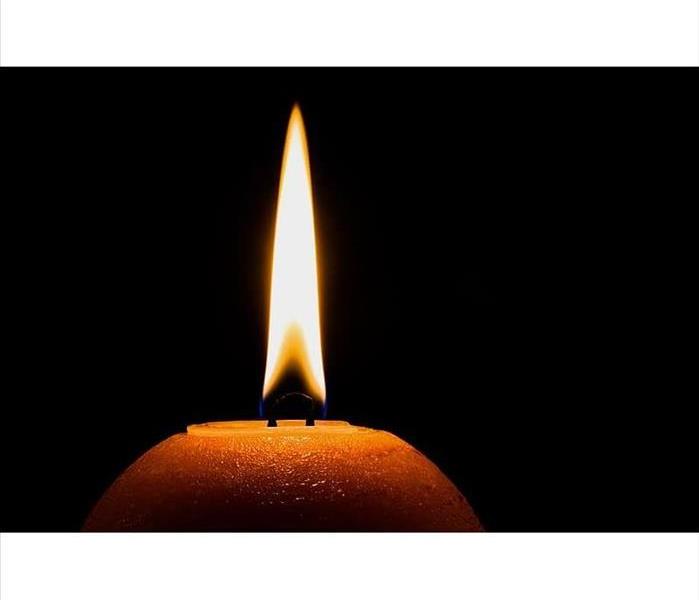 Always use caution while burning candles
Always use caution while burning candles
The U.S. Fire Administration released a Topical Fire Research Report in July of 2006 entitled, “Candle Fires in Residential Structures”, which examines the causes and characteristics of residential candle fires. According to the report, candles are responsible for an estimated 23,600 residential structure fires annually resulting in $390 million in direct property loss. Candle sales and usage increase during the winter and holiday season and peak in December. Almost 25% of candle fires occur during December and January. The number one cause of candle fires is placement near combustibles. Typically, the items initially ignited by candles include furniture, curtains, bedding and cabinetry. In December, holiday decorations are the first to ignite. Most candle fires result from accidental error and negligence, such as leaving burning candles unattended. Caution, common sense and attention to your surroundings can help reduce the risk of candle fires.
Some Tips for Candles Usage:
Ensure lit candles are in sturdy metal, glass, or ceramic candle holders and are placed where they cannot easily be knocked down
Keep candles out of reach from children and pets
Extinguish candles after us
Blow out all candles before napping or falling asleep
Never leave burning candles unattended
Always use caution while burning candles
Experienced fire damage? Give SERVPRO of York, James City County, and Poquoson a call.
757-229-3342 or toll free at 1-800-889-5002
General Fire Facts
5/22/2018 (Permalink)
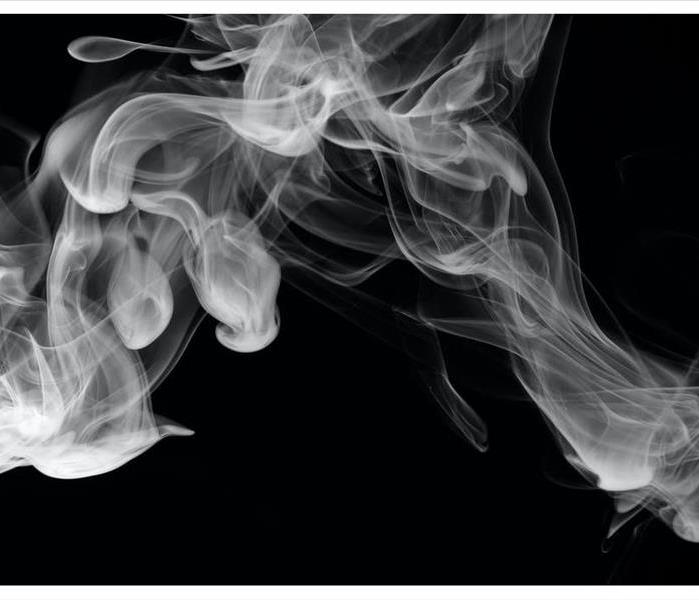 General Fire Facts
General Fire Facts
Fire Preventative Tips:
Install smoke alarms outside each sleeping area and every level of a home
Check smoke alarms once per month an change the batteries at least once per year
Plan an escape route and practice it at least twice per year
When our SERVPRO franchise arrives on the scene follow a fire, their first step is to calm the customer’s fears. The second step is to pre-test smoke to determine what type of fire has taken place. Knowing the types of smoke and their behavior patterns is crucial.
Are you aware of the different types of smoke?
Wet Smoke – Plastics & Rubber: low heat, smoldering, pungent odor, sticky, smears.
Dry Smoke – Paper & Wood: fast burning, high temperatures, heat rises, therefore the smoke rises.
Protein Smoke – Produced by evaporation of material rather than from a fire: virtually invisible, discolors paints and varnishes, extreme pungent odor.
Fuel Oil Soot – Furnace Puff Backs.
Smoke and soot residue can damage carpet, upholstery and contents if not removed quickly and efficiently. In a fire-damaged structure with soot on the walls and other surfaces, cleaning and restoration is less disruptive and more cost-efficient than replacement. Replacement may also mean a longer disruption time than restoration. For a company waiting to open for business, this downtime can present an enormous hardship.
Pre-testing helps to determine:
The most effective cleaning and restoration processes
Pre-existing conditions
The extent of the loss
Overall costs of the restoration process
Replacements
What is restorable and what must be replaced
If you find yourself in a fire event please reach out to SERVPRO and let us help you 757-229-3442 or toll free 1-800-889-5002



 24/7 Emergency Service
24/7 Emergency Service














